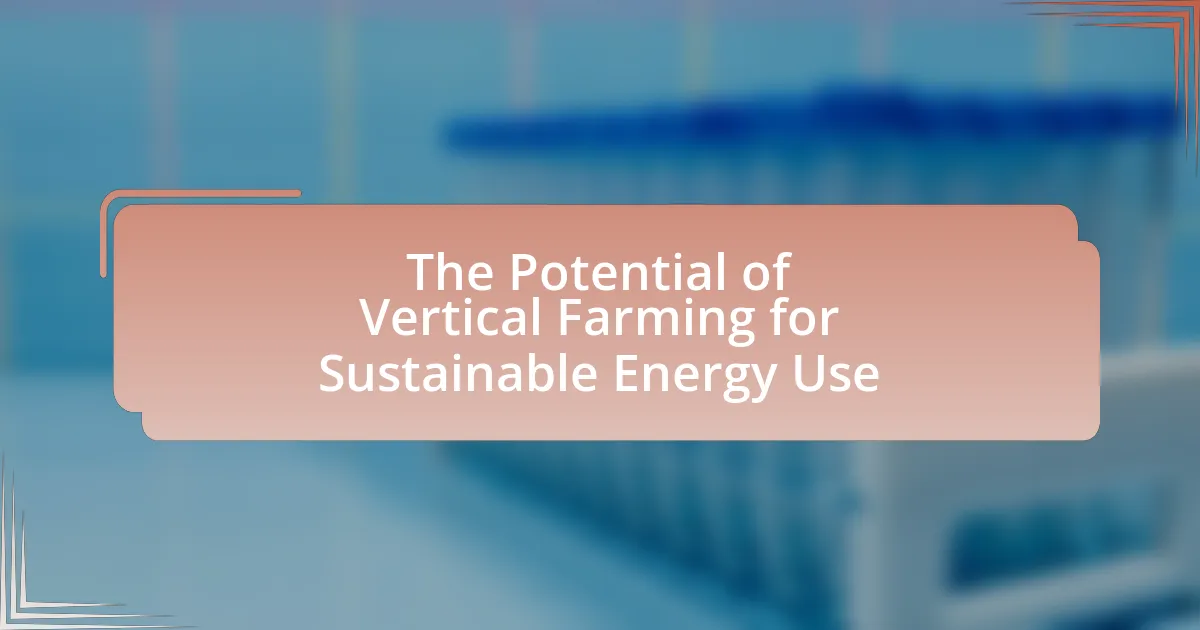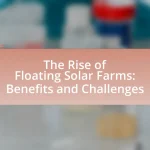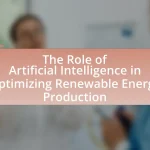Vertical farming is an innovative agricultural method that involves growing crops in vertically stacked layers, utilizing controlled-environment agriculture technology to enhance sustainability and energy efficiency. This practice significantly reduces land use and water consumption, with vertical farms using up to 95% less water than traditional farming methods. The integration of renewable energy sources, such as solar panels, further minimizes carbon footprints and operational costs. However, vertical farming faces challenges, including high energy consumption for lighting and climate control, as well as economic barriers related to initial setup and ongoing operational costs. The article explores the technologies, environmental benefits, and future trends of vertical farming, emphasizing its potential role in sustainable energy use and food security.
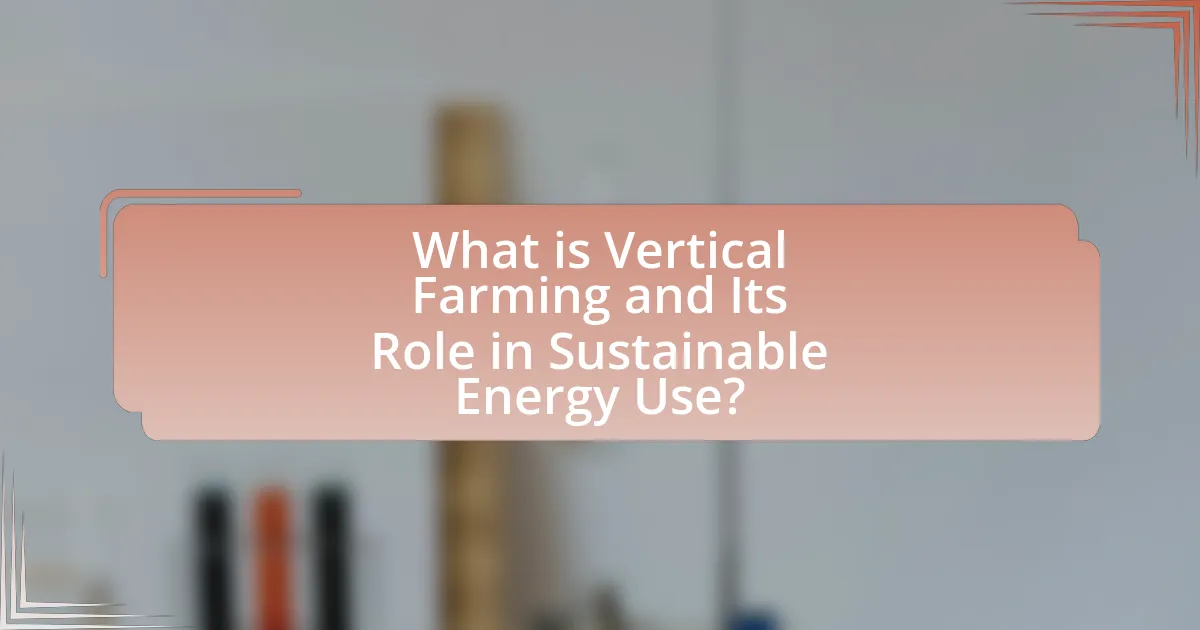
What is Vertical Farming and Its Role in Sustainable Energy Use?
Vertical farming is an innovative agricultural practice that involves growing crops in vertically stacked layers, often utilizing controlled-environment agriculture technology. This method significantly reduces land use and can enhance energy efficiency by integrating renewable energy sources, such as solar panels, to power lighting and climate control systems. Research indicates that vertical farms can use up to 95% less water than traditional farming methods, while also minimizing transportation emissions by locating farms closer to urban centers. These efficiencies contribute to a more sustainable energy use model, aligning with global efforts to reduce carbon footprints and promote food security in densely populated areas.
How does vertical farming contribute to energy efficiency?
Vertical farming contributes to energy efficiency by utilizing controlled environments that optimize resource use, significantly reducing energy consumption compared to traditional agriculture. For instance, vertical farms often employ LED lighting systems that are more energy-efficient than conventional lighting, consuming up to 90% less energy while providing the specific light spectrum needed for plant growth. Additionally, vertical farming systems can integrate renewable energy sources, such as solar panels, further decreasing reliance on fossil fuels and minimizing carbon footprints. Studies indicate that vertical farms can produce crops using 70-95% less water and 50% less energy than traditional farming methods, demonstrating their potential for sustainable energy use.
What technologies are utilized in vertical farming for energy conservation?
Vertical farming utilizes several technologies for energy conservation, including LED lighting, climate control systems, and renewable energy sources. LED lighting is energy-efficient, consuming up to 75% less energy than traditional lighting while providing the specific light spectrum needed for plant growth. Climate control systems, such as advanced HVAC and thermal insulation, optimize temperature and humidity, reducing energy consumption. Additionally, integrating renewable energy sources like solar panels can further decrease reliance on non-renewable energy, enhancing sustainability in vertical farming operations.
How does the location of vertical farms impact their energy use?
The location of vertical farms significantly impacts their energy use due to factors such as climate, proximity to energy sources, and urban infrastructure. For instance, vertical farms situated in regions with abundant sunlight can reduce reliance on artificial lighting, thereby lowering energy consumption. Additionally, farms located near renewable energy sources, such as solar or wind, can utilize cleaner energy, further decreasing their carbon footprint. Research indicates that urban vertical farms benefit from reduced transportation energy costs, as they can supply fresh produce directly to nearby markets, minimizing the energy associated with food distribution.
What are the environmental benefits of vertical farming?
Vertical farming offers significant environmental benefits, including reduced land use, decreased water consumption, and minimized pesticide use. By utilizing stacked layers of crops, vertical farms can produce food in urban areas, thereby conserving arable land and reducing the need for deforestation. Research indicates that vertical farming can use up to 90% less water than traditional farming methods due to recirculating systems that optimize water usage. Additionally, vertical farms often employ integrated pest management techniques, which can lead to a substantial reduction in chemical pesticide application, promoting healthier ecosystems. These practices contribute to a more sustainable agricultural model that addresses food security while minimizing environmental impact.
How does vertical farming reduce carbon emissions?
Vertical farming reduces carbon emissions primarily by minimizing the need for transportation and optimizing resource use. Traditional agriculture often requires long-distance transport of produce, which contributes significantly to greenhouse gas emissions. In contrast, vertical farms can be located closer to urban centers, thereby reducing transportation distances and associated emissions. Additionally, vertical farming employs energy-efficient technologies such as LED lighting and climate control systems, which can lower energy consumption compared to conventional farming methods. Research indicates that vertical farming can reduce carbon emissions by up to 90% compared to traditional agriculture, particularly when powered by renewable energy sources.
What role does vertical farming play in water conservation?
Vertical farming plays a significant role in water conservation by utilizing advanced irrigation techniques that reduce water usage compared to traditional farming methods. Specifically, vertical farms can use up to 90% less water due to systems like hydroponics and aeroponics, which deliver water directly to plant roots, minimizing evaporation and runoff. This efficiency is crucial in addressing global water scarcity, as agriculture accounts for approximately 70% of freshwater use worldwide. By optimizing water use, vertical farming not only conserves this vital resource but also enhances food production in urban areas, reducing the need for long-distance transportation and its associated water footprint.
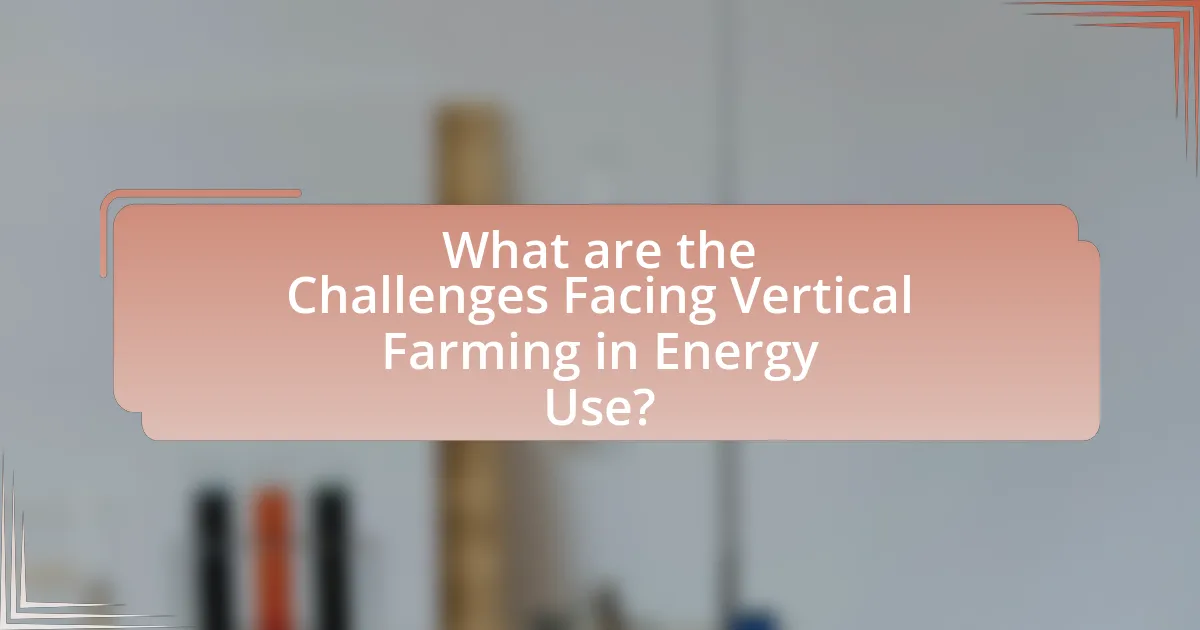
What are the Challenges Facing Vertical Farming in Energy Use?
Vertical farming faces significant challenges in energy use, primarily due to high energy consumption for lighting, climate control, and irrigation systems. These farms often rely on artificial lighting, which can account for up to 40% of their total energy usage, leading to increased operational costs and a larger carbon footprint. Additionally, maintaining optimal growing conditions requires substantial energy for heating, cooling, and ventilation, further exacerbating energy demands. According to a study published in “Nature Sustainability,” energy efficiency in vertical farms is critical, as many operations currently consume more energy per kilogram of produce than traditional farming methods. This highlights the need for advancements in energy-efficient technologies and renewable energy integration to mitigate these challenges.
What are the economic barriers to implementing vertical farming?
The economic barriers to implementing vertical farming include high initial capital investment, operational costs, and market competition. Vertical farming requires substantial upfront investment for infrastructure, technology, and equipment, which can deter potential investors. For instance, a study by the University of California, Davis, indicates that the cost of establishing a vertical farm can range from $100 to $200 per square foot, significantly higher than traditional farming methods. Additionally, ongoing operational costs, such as energy consumption for lighting and climate control, can be substantial; reports suggest that energy expenses can account for up to 30% of total operational costs. Furthermore, vertical farms face competition from established agricultural practices and lower-cost produce from conventional farms, making it challenging to achieve profitability. These economic factors collectively hinder the widespread adoption of vertical farming.
How do initial setup costs affect the viability of vertical farms?
Initial setup costs significantly impact the viability of vertical farms by determining the financial feasibility and return on investment. High initial costs, which can range from $500,000 to several million dollars depending on the scale and technology used, can deter potential investors and operators. For instance, a study by the National Renewable Energy Laboratory indicates that the capital-intensive nature of vertical farming, including expenses for infrastructure, equipment, and technology, can lead to longer payback periods, making it less attractive compared to traditional farming methods. Consequently, if initial costs are not managed effectively, they can limit the growth and sustainability of vertical farming operations.
What ongoing operational costs must be considered?
Ongoing operational costs in vertical farming include energy expenses, labor costs, water usage, maintenance of equipment, and nutrient supply. Energy expenses are significant due to the reliance on artificial lighting and climate control systems, which can account for up to 30% of total operational costs. Labor costs involve wages for skilled workers needed for planting, harvesting, and system management. Water usage is critical, as efficient irrigation systems must be maintained, and nutrient supply costs arise from the need for fertilizers and growth media. These costs are essential to consider for the financial viability of vertical farming operations.
How does energy sourcing impact vertical farming sustainability?
Energy sourcing significantly impacts vertical farming sustainability by determining the carbon footprint and operational efficiency of these systems. Renewable energy sources, such as solar and wind, can reduce greenhouse gas emissions and lower energy costs, enhancing the overall sustainability of vertical farms. For instance, a study by the International Renewable Energy Agency (IRENA) found that integrating renewable energy into agricultural practices can decrease energy-related emissions by up to 70%. Conversely, reliance on fossil fuels increases operational costs and environmental degradation, undermining sustainability goals. Therefore, the choice of energy sourcing is crucial for maximizing the ecological benefits of vertical farming.
What renewable energy options are available for vertical farms?
Vertical farms can utilize several renewable energy options, including solar energy, wind energy, and biomass energy. Solar energy is harnessed through photovoltaic panels installed on rooftops or nearby areas, providing a sustainable power source for lighting and climate control systems. Wind energy can be captured using small wind turbines, which can supplement energy needs, especially in areas with consistent wind patterns. Biomass energy, derived from organic waste generated by the farm or surrounding community, can be converted into biogas or biofuels, further supporting energy requirements. These renewable energy sources contribute to reducing the carbon footprint of vertical farms and enhancing their sustainability.
How can vertical farms integrate with local energy grids?
Vertical farms can integrate with local energy grids by utilizing renewable energy sources, such as solar panels and wind turbines, to generate electricity on-site. This integration allows vertical farms to reduce their reliance on conventional energy sources, thereby decreasing their carbon footprint. For instance, a study by the National Renewable Energy Laboratory found that combining solar energy with vertical farming can lead to a 50% reduction in energy costs. Additionally, vertical farms can participate in demand response programs, where they adjust their energy consumption based on grid needs, further enhancing grid stability and efficiency. This symbiotic relationship not only supports local energy grids but also promotes sustainable agricultural practices.
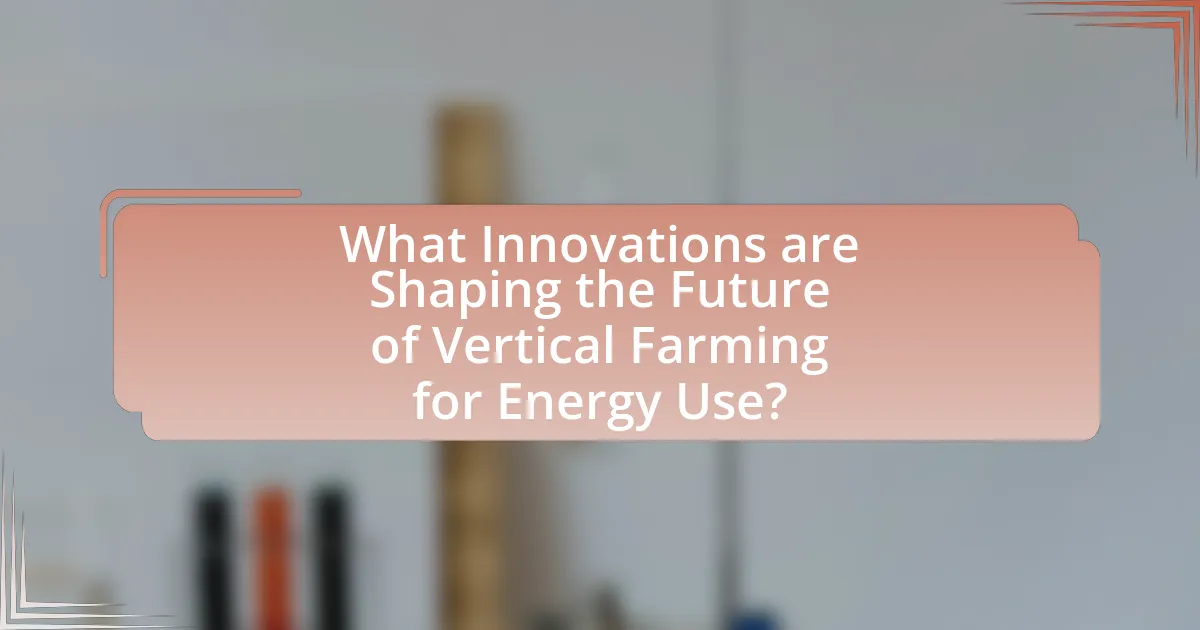
What Innovations are Shaping the Future of Vertical Farming for Energy Use?
Innovations shaping the future of vertical farming for energy use include advanced LED lighting systems, energy-efficient climate control technologies, and renewable energy integration. Advanced LED lighting systems, such as full-spectrum lights, significantly reduce energy consumption while optimizing plant growth, with studies showing up to 50% energy savings compared to traditional lighting. Energy-efficient climate control technologies, including smart sensors and automated systems, enhance energy management by adjusting conditions based on real-time data, leading to reduced energy waste. Additionally, the integration of renewable energy sources, such as solar panels, allows vertical farms to generate their own energy, further decreasing reliance on non-renewable sources and promoting sustainability. These innovations collectively contribute to making vertical farming a more energy-efficient and sustainable agricultural practice.
How are advancements in technology improving energy efficiency in vertical farms?
Advancements in technology are improving energy efficiency in vertical farms through the implementation of LED lighting, climate control systems, and automation. LED lighting significantly reduces energy consumption compared to traditional lighting, using up to 75% less energy while providing optimal light spectra for plant growth. Climate control systems, including advanced sensors and HVAC technologies, optimize temperature and humidity levels, reducing energy waste and enhancing plant health. Automation technologies, such as robotics and AI, streamline operations, minimizing labor costs and energy use by optimizing resource allocation and reducing human error. These technological innovations collectively contribute to a more sustainable energy model in vertical farming, supporting the industry’s growth and environmental goals.
What role do smart sensors play in optimizing energy consumption?
Smart sensors play a crucial role in optimizing energy consumption by providing real-time data on environmental conditions and resource usage. These sensors monitor factors such as temperature, humidity, and light levels, enabling precise control of energy-intensive systems like heating, cooling, and lighting in vertical farming. For instance, a study published in the journal “Renewable Agriculture and Food Systems” found that integrating smart sensors can reduce energy consumption by up to 30% in controlled environment agriculture. This data-driven approach allows for adaptive management, ensuring that energy is used efficiently, thereby enhancing sustainability in vertical farming practices.
How can automation enhance energy management in vertical farming?
Automation can enhance energy management in vertical farming by optimizing resource use and reducing waste. Automated systems, such as sensors and control algorithms, can monitor environmental conditions like temperature, humidity, and light levels in real-time, allowing for precise adjustments that minimize energy consumption. For instance, a study published in the journal “Renewable Agriculture and Food Systems” found that automated climate control systems can reduce energy use by up to 30% compared to manual systems. Additionally, automation facilitates the integration of renewable energy sources, such as solar panels, by managing energy storage and usage efficiently, further promoting sustainability in vertical farming practices.
What best practices can be adopted for energy-efficient vertical farming?
Energy-efficient vertical farming can adopt several best practices, including the use of LED lighting, optimized climate control systems, and water recycling techniques. LED lighting is crucial as it consumes up to 75% less energy than traditional lighting while providing the specific wavelengths needed for plant growth. Optimized climate control systems, such as advanced HVAC and CO2 enrichment, can reduce energy consumption by maintaining ideal growing conditions with minimal energy waste. Additionally, implementing water recycling techniques can significantly lower energy usage associated with water heating and distribution, as it minimizes the need for fresh water sourcing. These practices collectively enhance energy efficiency and contribute to the sustainability of vertical farming operations.
How can vertical farms maximize natural light usage?
Vertical farms can maximize natural light usage by incorporating reflective materials and optimizing plant placement to enhance light exposure. Utilizing reflective surfaces, such as mirrors or light-colored walls, can redirect sunlight to plants, increasing the amount of light they receive. Additionally, strategic plant arrangement, such as tiered systems or staggered planting, allows for better light distribution among crops. Research indicates that vertical farms employing these techniques can improve light efficiency by up to 30%, significantly enhancing photosynthesis and crop yields.
What strategies can be implemented to reduce energy waste?
Implementing energy-efficient technologies is a primary strategy to reduce energy waste in vertical farming. Utilizing LED lighting, which consumes up to 75% less energy than traditional lighting, can significantly lower energy consumption while providing optimal light for plant growth. Additionally, integrating smart climate control systems allows for precise monitoring and adjustment of temperature and humidity, further minimizing energy use. Research indicates that vertical farms can achieve up to 90% reduction in energy waste through these technologies, as demonstrated in a study by Al-Kodmany (2018) published in the Journal of Urban Technology.
What are the future trends in vertical farming related to sustainable energy use?
Future trends in vertical farming related to sustainable energy use include the integration of renewable energy sources, such as solar and wind power, to reduce reliance on non-renewable energy. This shift is driven by advancements in energy-efficient technologies, including LED lighting and climate control systems, which significantly lower energy consumption. For instance, a study by the University of Arizona found that vertical farms utilizing solar panels can achieve up to 50% reduction in energy costs compared to traditional farming methods. Additionally, the adoption of energy storage solutions, like batteries, will enable vertical farms to optimize energy use by storing excess energy generated during peak production times. These trends indicate a growing emphasis on sustainability and energy efficiency in the vertical farming sector.
How might policy changes influence vertical farming energy practices?
Policy changes can significantly influence vertical farming energy practices by establishing regulations and incentives that promote energy efficiency and renewable energy use. For instance, government subsidies for renewable energy installations can encourage vertical farms to adopt solar panels or wind turbines, reducing reliance on non-renewable energy sources. Additionally, policies mandating energy efficiency standards can drive vertical farms to implement advanced technologies, such as LED lighting and climate control systems, which optimize energy consumption. Evidence from the U.S. Department of Agriculture indicates that farms adopting energy-efficient practices can reduce energy costs by up to 30%, demonstrating the tangible benefits of supportive policy frameworks.
What role will consumer demand play in shaping energy use in vertical farming?
Consumer demand will significantly influence energy use in vertical farming by driving the adoption of energy-efficient technologies and practices. As consumers increasingly prioritize sustainability and local food production, vertical farms will be compelled to optimize their energy consumption to meet these expectations. For instance, a study by the Food and Agriculture Organization indicates that energy-efficient systems can reduce operational costs by up to 30%, making them more attractive to producers responding to consumer preferences for eco-friendly practices. Consequently, the alignment of consumer demand with sustainable energy solutions will shape the operational strategies of vertical farms, leading to innovations that enhance energy efficiency and reduce carbon footprints.
